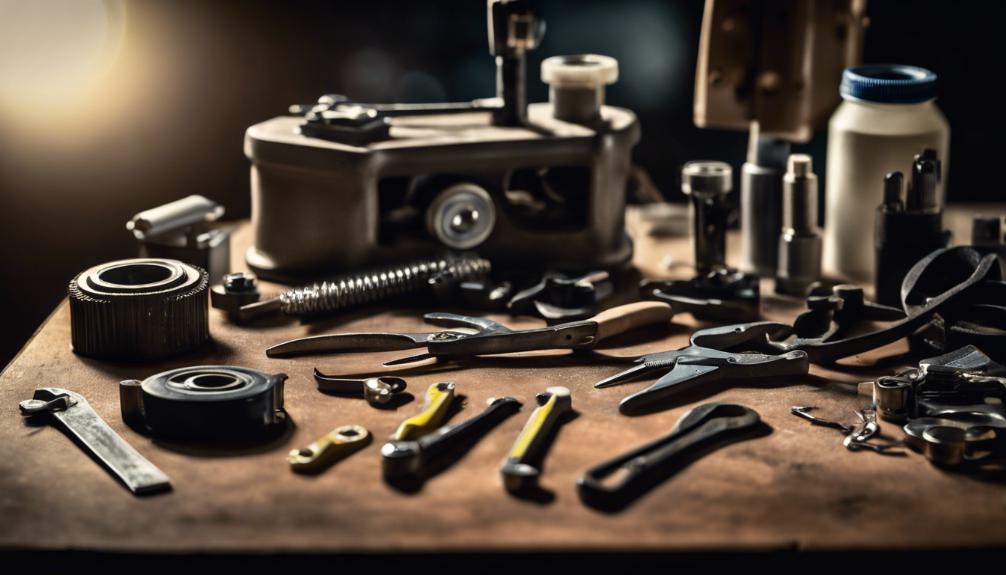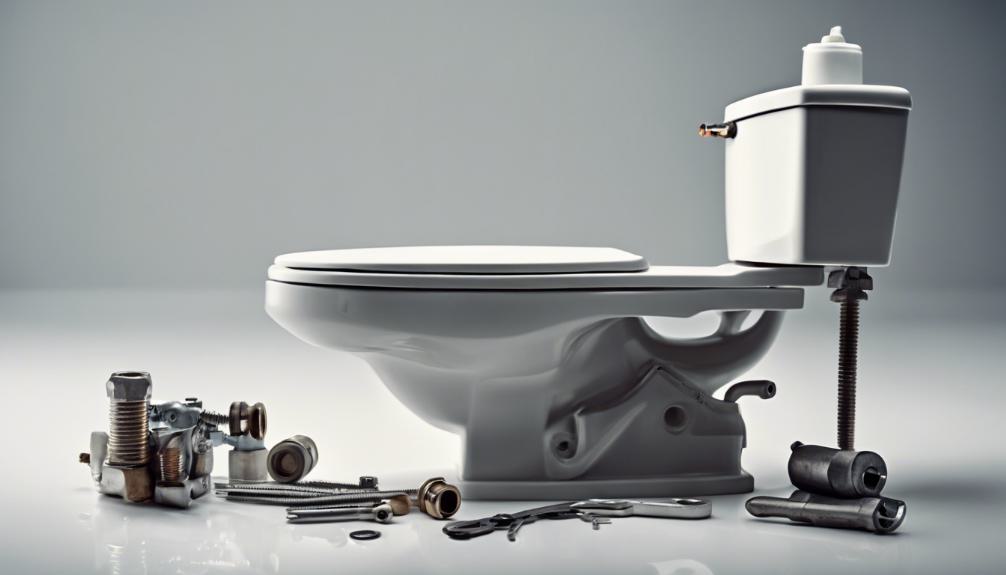Replace a Toilet Flapper in 5 easy steps and save up to 200 gallons of water daily.
Gather tools:
adjustable pliers,
needle-nose pliers,
screwdriver,
plus a new flapper matching your toilet's specs.
Shut off the water supply by locating the shut-off valve and turning it clockwise.
Disassemble the toilet tank and drain it completely.
Remove the old flapper valve and inspect the area for mineral buildup.
Install the new flapper valve and test the repaired toilet.
Key Takeaways
• Shut off the water supply by locating the shut-off valve and turning it clockwise to ensure a safe repair environment.
• Remove the old flapper valve by disconnecting it from the fill valve, loosening the mounting nut, and lifting it off.
• Install the new flapper valve by aligning it with the fill valve, threading the mounting nut correctly, and adjusting the chain length.
• Test the repaired toilet by flushing it multiple times, observing its behavior, and checking for water conservation signs and leaks.
• Ensure the new flapper valve is functioning properly by lifting it to verify a proper seal and checking for mineral buildup in the area.
Gathering Essential Tools and Materials

Gather Essential Tools and Materials
Tools:
- Adjustable pliers
- Needle-nose pliers
- Wrench
- Screwdriver
If you don't have these tools, add them to your shopping list.
Materials:
- Replacement flapper (matching your toilet's specifications)
- Plumber's tape
- New chain or flapper seat (if necessary)
Why it's essential:
Having all necessary tools and materials ensures a smooth replacement process, saving you time and frustration.
Shutting Off the Water Supply
Now that you've gathered all the necessary tools and materials, it's time to shut off the water supply to the toilet.
You'll need to locate the shut-off valve, which is typically found near the toilet or under the sink. Make sure to identify the type of valve you have, as it will affect the steps you take to shut off the water supply.
Locate Shut-Off Valve
Locate Shut-Off Valve
The shut-off valve is usually on the wall behind the toilet. It's a lever or knob controlling the toilet's water supply.
To ensure a smooth repair process:
Turn the valve clockwise to shut off the water supply completely.
Verify the valve is fully closed before starting the repair to avoid water damage or flooding.
Inspect the valve regularly for signs of wear and tear as part of your Valve Maintenance routine.
Check the valve's water pressure to ensure it's within the recommended range for your toilet.
Identify Valve Type
Identify the shut-off valve type to ensure correct shut-off procedure.
Two common types of shut-off valves are gate valves and ball valves.
Gate valves have a rotating handle that closes the valve by moving a gate down into the valve seat. Turn the handle clockwise until it stops to shut off the water supply.
Ball valves use a rotating handle to turn a ball that blocks the flow of water. Turn the handle a quarter turn clockwise to shut off the water supply.
Correctly identifying the valve type is crucial to avoid damaging the valve or causing complications.
Disassembling the Toilet Tank

Now that you've shut off the water supply, it's time to disassemble the toilet tank.
You'll need to drain the tank completely, ensuring it's empty and free of water, before proceeding.
Next, you'll remove the tank-to-bowl nuts, which secure the tank to the bowl, allowing you to access the flapper.
Turn Off Water Supply
Turn Off Water Supply
To replace the toilet flapper, shut off the water supply. Locate the shut-off valve behind the toilet, near the floor. Rotate the valve clockwise until it stops. This guarantees a complete shut-off.
Verify the water supply is off by checking the valve. Ensure the tank is empty before proceeding with the repair.
Shut-Off Valve Location: Behind the toilet, near the floor.
Shut-Off Procedure:
- Rotate the valve clockwise until it stops.
- Check the valve to confirm the water supply is off.
- Verify the tank is empty before proceeding with the repair.
Drain the Tank Completely
Drain the tank completely by shutting off the water supply and flushing the toilet multiple times to remove as much water as possible. This step is crucial for a safe and mess-free repair process.
To conserve water, consider the tank capacity of your toilet and implement the following water-saving tips:
| Tank Capacity | Water Conservation Tips |
|---|---|
| 1.6 gallons | Install low-flow toilets |
| 3.5 gallons | Fix leaks promptly |
| 5 gallons | Use dual-flush toilets |
| 7 gallons | Upgrade to a water-efficient toilet model |
Once the tank is drained, you can access the flapper and internal components. Handle the tank's internal mechanisms carefully to avoid accidental water spills. With the tank drained, you're one step closer to replacing the flapper and fixing the toilet leak.
Remove Tank-to-Bowl Nuts
Remove the Tank-to-Bowl Nuts
Disconnect the toilet tank from the bowl by removing the tank-to-bowl nuts. This allows access to internal components.
Identify Nuts
Locate the tank-to-bowl nuts at the bottom of the tank.
Choose Correct Tool
Select a wrench or pliers that fit the nut securely to avoid stripping or damaging the bolt.
Loosen Nuts
Apply gentle, consistent force to loosen the nuts. Avoid damaging surrounding porcelain.
Store Nuts Safely
Place removed nuts in a safe location to prevent loss or misplacement.
Important Considerations
Note the type of nut used, as some toilets may have specialized bolts or rust-resistant coatings for rust prevention.
Removing the Old Flapper Valve
Removing the Old Flapper Valve
Disconnect the old flapper valve from the fill valve by loosening the flapper's mounting nut. This nut holds the flapper in place, so be prepared to apply force to break it free.
Once loose, carefully lift the flapper off the fill valve. Avoid touching surrounding components to prevent introducing dirt or debris into the system.
Examine the old flapper valve's design. Is it a traditional rubber flapper or a corrosion-resistant design? Check for signs of valve corrosion, which can cause leaks.
Remove the old flapper valve and inspect the area for mineral buildup or debris. Clean the area as needed.
With the old flapper valve removed, you're closer to a leak-free toilet.
Installing the New Flapper Valve

Install the New Flapper Valve
Align the new flapper valve with the fill valve, ensuring the mounting nut is threaded correctly. Proper alignment and orientation are crucial for a leak-free seal.
Mount the flapper by threading the mounting nut onto the fill valve, securing it tightly.
Adjust the chain length to ensure the flapper opens and closes smoothly.
Confirm the valve is level and plumb to prevent continuous water flow.
Gently lift the flapper to verify it seals properly and doesn't leak.
Testing the Repaired Toilet
Testing the Repaired Toilet
Flush the toilet multiple times to confirm the new flapper valve's performance and identify potential issues. Perform several flushes to ensure the flapper seals properly and doesn't leak.
Observe the toilet's behavior during each flush, checking for water conservation signs, such as complete stop of water flow after the tank refills. Inspect the flapper valve and surrounding areas for signs of moisture or water droplets, indicating a leak.
For thorough leak detection, add a few drops of food coloring or a dye test tablet to the toilet tank. Wait 30 minutes without flushing. If the color appears in the bowl, water is likely leaking from the tank into the bowl.
A properly functioning flapper valve is essential for water conservation, preventing unnecessary water waste.
Frequently Asked Questions
Can I Repair a Toilet Flapper Instead of Replacing It?
You can try to repair a toilet flapper by cleaning it thoroughly or adjusting its chain to improve its seal, but if the flapper's damaged, replacement is usually the best option for a reliable fix.
Will a New Flapper Valve Affect Toilet Water Consumption?
When you install a new flapper valve, you'll likely notice improved water efficiency, as modern designs incorporate conservation methods that reduce water consumption, ultimately saving you money on your water bill.
Can I Use a Flapper Valve From a Different Toilet Brand?
You can use a flapper valve from a different brand, but make sure it's compatible; look for universal fit designs or check the manufacturer's specifications to guarantee a seamless installation and best performance.
How Often Should I Replace My Toilet Flapper Valve?
You should replace your toilet flapper valve every 4-7 years, depending on usage and water quality, as part of regular toilet maintenance to prevent leaks and guarantee peak performance, as flapper lifespan varies.
Can a Faulty Flapper Valve Cause Toilet Leaks?
You'll likely experience leaky toilets if your flapper valve is faulty, as it fails to seal properly, allowing water to continuously flow into the bowl, resulting in water waste and increased utility bills.
Conclusion
You've successfully replaced the toilet flapper, restoring proper function to your toilet. Confirm that the new flapper seats properly and the chain is adjusted correctly to prevent constant running.
Test the toilet multiple times to validate the repair. If issues persist, revisit each step to troubleshoot.
With this DIY repair, you've saved time and money, and gained confidence in tackling future plumbing tasks.
